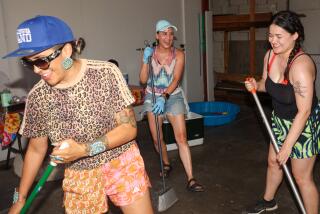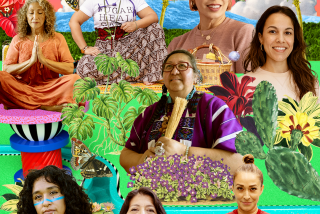Southern California Voices / A FORUM FOR COMMUNITY ISSUES : MAKING A DIFFERENCE: Community Action for Women’s Health : Multicultural Medicine
People with no health insurance and little tradition of using Western medicine often don’t realize they have a treatable illness such as hypertension until they end up in the emergency room.
A new project reaches two groups with specific health problems, Samoan immigrants and American Indians. It offers to older women in each group health advice and assistance that they can share with their families.
Community Action for Women’s Health began in 1994 with a $400,000 grant from the California Wellness Foundation. Overseen by Santa Monica-based Senior Health and Peer Counseling, it targets women in Samoan and Indian cultures because they have similar health problems, including obesity, hypertension and diabetes, and tend to see complications at a younger age than the general population. Coordinator Fran D. Goldfarb says the program’s strength is that it stresses low cost, community involvement and cultural sensitivity. “We try to show that healthier lifestyles are in line with their traditional ways.”
Nearly 500 women between the ages of 40 and 80 have taken courses on topics including nutrition, exercise, breast and cervical cancer and menopause. “When we started, it was hard to find any literature in Samoan, even when we called the Red Cross in American Samoa,” says Goldfarb. The group has translated some materials itself and persuaded the the Food and Drug Administration to produce mammography information in Samoan.
Goldfarb also measures the project’s success in the fact that “children of our graduates say how their mothers are talking to them about eating better and exercising. That’s how change begins.”
MAKING IT WORK
Project staff worked with the American Indian Clinic, the Southern California Indian Center, the Samoan Federation and the National Office of Samoan Affairs, in Los Angeles and Orange counties, to make health education culturally sensitive. Some examples of tailoring:
CLASSES: The estimated 100,000 Samoans in Southern California, the nation’s largest contingent, are a close-knit group concentrated around Carson, says Goldfarb. Samoan participants opted to receive more than 70 hours of instruction over eight weeks at a single location and conclude with a graduation.
Conversely, the 45,000 American Indians in the region represent more than 300 tribesand are widely dispersed. Classes on a single topic is presented monthly at up to five locations to reach as many people as possible, since many women lack transportation.
SURVEYS: Samoans responded to written questions without hesitation. However, Native Americans found them intrusive. The compromise was to ask questions orally to allow what the culture calls a “polite pause” for second thoughts. Answers are placed on papers resembling a traditional medicine wheel (above) printed on them.
ADVICE: Diets in both cultures use a lot of fat. “Getting Samoans to give up [highly saturated] coconut oil is like pulling teeth without Novocain,” says Goldfarb. Instead of alienating Samoan women by calling for a ban, educators recommend healthier oils, leaner meat and getting more exercise to offset the coconut oil.
A PARTICIPANT’S STORY
“As an Indian, you always think they’ll come around to us last. But in this project, we’re first on the list. When I would see [prevention information] on TV or someplace else, I would think. “That’s just for rich people.” But the project helped me lose 50 pounds and my blood sugar is way down. And my husband,two daughters and four sons, who are also really overweight, are losing pounds too.”
-Georgianna Shot, 55, a Lakota Sioux who lives in Bell
AN OBSERVER’S VIEW
“By working within the community, this project has a level of credibility that outside groups trying to share the same information wouldn’t have. It’s planting seeds so these groups take this material and make it their own. That can enhance the health of both communities.”
-Steve Wallace, assistant professor of public health, UCLA
More to Read
Sign up for Essential California
The most important California stories and recommendations in your inbox every morning.
You may occasionally receive promotional content from the Los Angeles Times.










